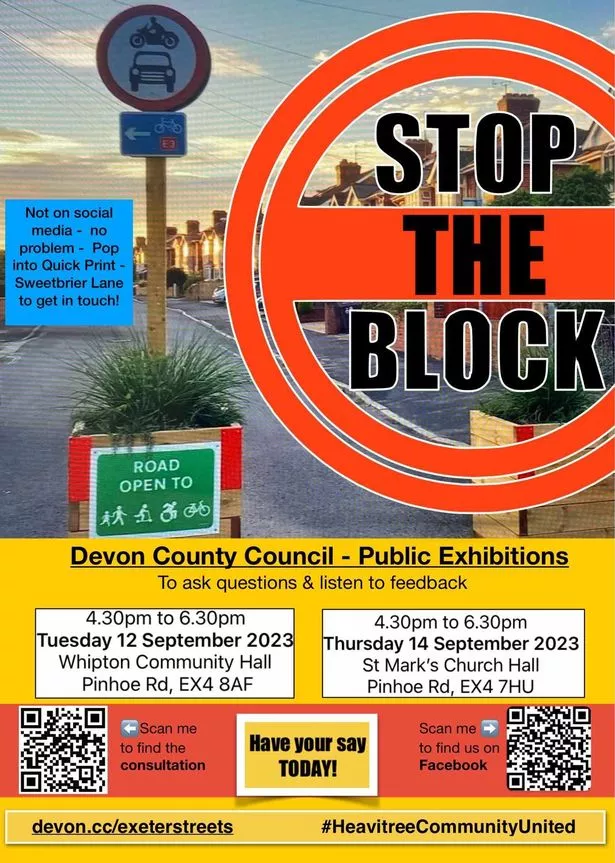LTNs can delay emergency vehicles by up to 45 seconds… but “streets feel safer and more sociable without traffic” [Oxford]
.
As reported in the Observer, “the new road rage is happening”, as bitter rows break out over UK’s low-traffic neighbourhoods – and that was from September 2020.
As barriers and signs go up to stop rat runs and promote cycling and walking, communities are deeply divided over the benefits… Yet these apparently modest traffic management changes have sparked sometimes bitter rows, with increasing vocal opposition groups arguing the schemes only really benefit the entitled middle classes in leafy enclaves at the expense of those living in surrounding neighbourhoods or who are dependent on their cars.
There’s not much let up, as the Mail reports more recently on Inside the Low Traffic Neighbourhoods dividing communities in Britain.
EXETER:

Last week, demonstrations against the proposed low-traffic neighbourhoods for Exeter were held outside County Hall – following on from a group of residents claiming a proper consultation had not been conducted by the County Council.
And this week, “an army of furious Exeter residents met over the LTN scheme“, with lots of comment on the Devon Live page:
“LTNs can work if they’re built from the start of development, and if the surrounding major roads have sufficient capacity. These schemes are being shoe-horned in to places where the surrounding roads didn’t have sufficient capacity *before* the extra traffic was forced onto them, the end result being gridlock and ridiculous journey times.”
With the Heavitree and Exeter Community United social media pages following on from the demonstrations.
Tempers are running high, with Exeter City Council asking the public to inform on drivers who flaunt LTN road blockages because the traffic calming scheme has no enforcement cameras.
OXFORD:
Looking to where the LTP project has been underway for some time, the Oxford Mail has been covering the campaigns and latest consultations.
And one idea is for cameras to replace traffic-calming bollards in Cowley, which might be a way forward for Exeter:
A council has decided to replace controversial traffic-calming measures with Automatic Number Plate Recognition (ANPR) cameras on three Oxford roads. This will give taxis, buses, postal and emergency service vehicles free access through some of Cowley Low Traffic Neighbourhood (LTN)… Simulation data suggested the LTNs can delay emergency vehicles by up to 45 seconds if the vehicle has to be re-routed. The proposed ANPR cameras will instead check the number plates of all vehicles passing through the restricted area and cross reference them against an exemptions list.
Meanwhile, down a street in Oxford, LTN residents defend the scheme after several attacks:
Residents in St Mary’s, home to ‘Britain’s most hated bollard’, say streets feel safer and more sociable without traffic
In a terraced neighbourhood of east Oxford, a nationally divisive issue has triggered acts of arson, violence, theft and vandalism. Is it Brexit? No. Channel crossings? No. Public sector strikes? No. It’s bollards.
The bollards in question form part of the St Mary’s low-traffic neighbourhood (LTN), a scheme replicated across England, in which motor vehicles are prevented from taking shortcuts by posts, planters and other measures in an attempt to create quieter and safer streets for the residents. One of the road blocks in the St Mary’s LTN on Howard Street has been named “Britain’s most hated bollard” by tabloids after CCTV captured it being repeatedly stolen, deliberately knocked down and even set on fire.
LTNs have caused bitter arguments up and down the country, with critics claiming they push car use to busier main roads, slow down emergency response times and are damaging for nearby businesses. But in east Oxford, where the furore around LTNs has led national press and even the crew of BBC Panorama to descend on the otherwise uneventful neighbourhood, those in support of the measures are mounting a fightback against the relentless attempts to remove, destroy and undermine the bollards and planters.
…